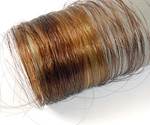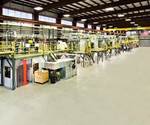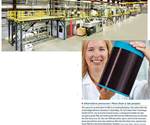Alternative precursor R&D: First commercial use of lignin carbon fiber?
GrafTech International (Independence, OH, US) is working with Oak Ridge National Laboratory (Oak Ridge, TN, US) and the US Department of Energy’s Advanced Manufacturing Office to develop lignin fiber manufacturing and demonstrate it in viable products.
GrafTech International (Independence, OH, US) is working with Oak Ridge National Laboratory (ORNL, Oak Ridge, TN, US) and the US Department of Energy’s Advanced Manufacturing Office (DoE AMO) in a collaborative effort to develop lignin fiber manufacturing and demonstrate it in viable products. The company is investigating lignin-based carbon fiber for GrafTech’s trademarked GRAFSHIELD and FiberForm high-temperature industrial furnace insulation products (FiberForm was formerly produced by Fiber Materials Inc., now part of GrafTech).
Ryan Paul, innovation and technology manager at GrafTech, explains that his company’s current insulation products are made with pitch or rayon-based carbon fiber, but that the company wanted a US-based and lower cost fiber source. That led GrafTech to work with ORNL several years ago, when a prototype lignin fiber insulation product was produced and tested, using hardwood-sourced lignin precursor. GrafTech was awarded a cooperative agreement by DoE AMO in late 2014 to advance the technology readiness level (TRL) of lignin technology by overcoming some of the key technical challenges associated with lignin precursors and fiber production scale-up.
GrafTech prefers pure lignin, with minimal addition of polymers, at least for now, explains Paul. “High purity is key, with little ash and other contaminants, so that the fibers can be melt spun. We’re also targeting a specific range of molecular weight in the precursor.”
A big challenge, says Paul, is that each lignin source varies, and a stable supply chain consisting of multiple suppliers is needed: “We are identifying a range of US lignin suppliers and trying to determine what source, and even what species of plant, is best.”
The concept is that fibers are melt-blown into a web, and the entire web is stabilized at a temperature between 250°C and 300°C, and then carbonized. ORNL’s carbon fiber line is now fully operational; GrafTech plans to scale up the technology to the next level in 2016 to 2017, and as the project moves forward and meets its milestones, GrafTech will assess bringing the product to market.
The mat form is expected to work well for GrafTech’s products, because fibers are milled, sized and processed into rigid insulation panels. The fibers ultimately are bonded together and aligned parallel to the wall of a furnace when the insulation is installed, providing through-plane thermal conductivity of 0.45 W/mK at 1500°C, yet offering enough strength to withstand handling and machining. Adds Paul, “We expect to get good fiber quality, but we can also get away with some fiber porosity and some shorter fibers, and still get the functionality we need.”
“It’s a matter of understanding the performance requirements for an application, and maximizing the value of the fiber product for that application. We don’t need aerospace-grade, perfect fiber for many of these kinds of high-volume uses,” asserts ORNL’s technology development manager for carbon and composites, Cliff Eberle.
Paul adds that “we’re going for the ‘low-hanging fruit’ here, with a sustainable, and ultimately customizable, carbon fiber solution that’s half the price of our current product.”
This short article is a Side Story that accompanied CW's Feburary 2016 feature article titled, "Alternative precursor R&D: Lignin in the lightweighting limelight." To read the main article, click on its title under "Editor's Picks," at top right.
Related Content
Thermoset-thermoplastic joining, natural fibers enable sustainability-focused brake cover
Award-winning motorcycle brake disc cover showcases potential for KTM Technologies’ Conexus joining technology and flax fiber composites.
Read MoreProtecting EV motors more efficiently
Motors for electric vehicles are expected to benefit from Trelleborg’s thermoplastic composite rotor sleeve design, which advances materials and processes to produce a lightweight, energy-efficient component.
Read MoreMaterials & Processes: Tooling for composites
Composite parts are formed in molds, also known as tools. Tools can be made from virtually any material. The material type, shape and complexity depend upon the part and length of production run. Here's a short summary of the issues involved in electing and making tools.
Read MoreJeep all-composite roof receivers achieve steel performance at low mass
Ultrashort carbon fiber/PPA replaces steel on rooftop brackets to hold Jeep soft tops, hardtops.
Read MoreRead Next
Alternative precursor R&D: What are the alternatives to PAN?
Carbon fibers made from other precursors are in use, commercially, and many more precursor alternatives have been investigated.
Read MoreAlternative precursor R&D: Oak Ridge National Laboratory
Oak Ridge National Laboratory (ORNL, Oak Ridge, TN, US) has been at the forefront of North American research into alternatives to the polyacrylonitrile (PAN) precursor used to make aerospace-grade carbon fiber.
Read MoreAlternative precursor R&D: Lignin in the lightweighting limelight
This abundant, renewable resource shows promise as an alternative to PAN for low-cost, functional carbon fibers.
Read More






















